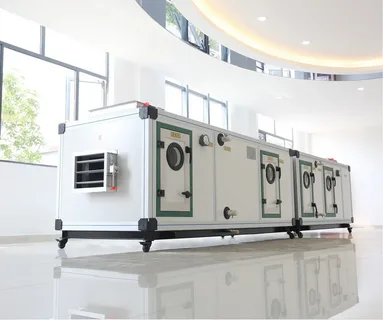In creating a comfortable and healthy living environment, air ventilation plays an indispensable role. It’s not just about air circulation; it’s about ensuring that the air quality inside your home meets the highest standards of cleanliness and freshness. Proper ventilation becomes even more crucial as we close our homes to conserve energy and maintain warmth, especially during colder months. An effective air-ventilation system can significantly enhance your indoor climate, improve air quality, and ultimately contribute to better health and comfort.
Understanding the Role of Fresh Air-Heaters in Ventilation Systems
Fresh air-heaters are vital in regions with colder climates, where it’s important to maintain warmth and indoor air quality. These systems pull in outdoor air, heat it to a comfortable level, and distribute it throughout the home. This continuous exchange ensures stale indoor air is replaced with fresh, heated air, thus maintaining a comfortable temperature without compromising air quality.
Integrating fresh air-heaters into your ventilation strategy lets you keep your home warm and inviting while ensuring a steady supply of fresh air, enhancing overall indoor comfort. Fresh air-heaters also help manage humidity levels, which can be particularly beneficial in colder climates where indoor air tends to be dry.
By introducing a steady flow of fresh, heated air, these systems prevent the air from becoming overly dry, which can contribute to respiratory issues and discomfort. Furthermore, modern fresh air-heaters are often designed with advanced controls that allow homeowners to adjust the temperature and airflow to suit their preferences, ensuring optimal comfort throughout the year.
Significance of a Fresh Air Heater
A fresh air-heater is crucial in maintaining a comfortable and healthy indoor environment. Introducing fresh, warm air into a space ensures occupants enjoy consistent and pleasant temperatures during colder months. This device is particularly significant in well-insulated or airtight buildings with limited natural ventilation.
One of the key benefits of a fresh air heater is its ability to improve indoor air quality. It helps to dilute and remove indoor pollutants by replacing stale air with fresh, filtered air. This is vital for reducing the concentration of allergens, dust, and other airborne contaminants, contributing to a healthier living environment. A fresh air-heater enhances comfort by providing consistent warmth.
Unlike traditional heating systems that might only warm specific areas, a fresh air-heater distributes warm air evenly throughout the space. This helps to eliminate cold spots and ensures a uniform temperature, which is particularly beneficial in larger or multi-room spaces. Furthermore, using a fresh air-heater can be more energy-efficient than other heating methods. Many models are designed to work with energy recovery systems, which can reduce overall heating costs by using less energy to achieve the desired temperature.
Exploring Modern Air-Ventilation Techniques
Modern air-ventilation techniques cater to the specific needs of contemporary homes, with a focus on energy efficiency and user comfort. Mechanical Ventilation with Heat Recovery (MVHR) systems are a prime example, designed to retain home warmth while introducing fresh air, thus minimizing energy use. Smart ventilation systems are also increasingly popular, allowing homeowners to monitor and control air quality through mobile apps.
These advancements ensure that today’s homes benefit from high-quality air without sacrificing energy efficiency. Additionally, innovations like demand-controlled ventilation adjust airflow based on occupancy and air quality levels, optimizing performance and ensuring a comfortable living environment. MVHR systems are particularly effective in maintaining indoor air quality while reducing energy consumption.
They work by extracting stale air from indoor spaces and passing it through a heat exchanger, transferring the heat from the outgoing air to the incoming fresh air. This process improves ventilation and helps retain heat, making it an energy-efficient solution for homes. Smart ventilation systems take this further by incorporating sensors and controls that adjust ventilation rates based on real-time data, ensuring that air quality remains optimal while minimizing energy use.
The Function and Benefits of an Air Ventilation Unit
An air ventilation unit provides continuous fresh air while expelling stale air from your home. These units are essential for maintaining indoor air quality, reducing humidity, and preventing the accumulation of pollutants and allergens. By facilitating proper air exchange, they help to control moisture levels, thus preventing issues like mould growth.
Modern air-ventilation units often come equipped with advanced filtration systems, which can remove particulates, odours, and harmful gases, creating a healthier indoor environment. The energy-efficient designs of these units ensure that while enhancing air quality, they also contribute to lowering energy consumption, making them a smart addition to any home.
In addition to improving air quality, air-ventilation units can also help to enhance overall comfort by regulating indoor temperatures and humidity levels. By ensuring a constant flow of fresh air, these units prevent the air inside your home from becoming stuffy or stale, contributing to a more pleasant living environment. Many modern units also feature programmable settings that allow homeowners to customize ventilation schedules to match their daily routines, further enhancing comfort and convenience.
Key Features of Modern Ventilation Units
Modern ventilation units have advanced features designed to improve indoor air quality and enhance comfort. Here are some key features to consider:
Energy Recovery
Many modern ventilation units include energy recovery systems, such as heat recovery ventilators (HRVs) or heat exchange ventilators (ERVs). These systems transfer heat from the outgoing stale air to the incoming fresh air, reducing the energy required for heating or cooling and improving overall energy efficiency.
Variable Speed Fans
Modern ventilation units are equipped with variable-speed fans, which allow for precise control of airflow. This feature helps to adjust ventilation rates based on the space’s specific needs, providing optimal air exchange while minimizing energy consumption.
Smart Controls
Advanced ventilation units often come with smart control options, allowing users to program and monitor their systems remotely via smartphone apps or home automation systems. These controls enable easy adjustments to ventilation schedules, real-time monitoring of air quality, and integration with other home systems for enhanced convenience and efficiency.
High-Efficiency Filters
Modern units typically feature high-efficiency filters that capture a wide range of airborne particles, including dust, pollen, and allergens. These filters improve indoor air quality by removing contaminants, contributing to a healthier living environment.
Quiet Operation
Noise reduction is a priority in contemporary ventilation units. Many models are designed with sound-absorbing materials and advanced fan technology to minimize operational noise, ensuring the ventilation system works quietly without disrupting daily activities.
How a Balanced Ventilation System Can Improve Air Quality
A balanced ventilation system manages the intake and exhaust of air, ensuring consistent air pressure within your home. This prevents draughts and energy loss by stopping outside air from entering through unintended gaps. By delivering fresh air to all areas and expelling stale air, these systems enhance air quality and improve the efficiency of your heating and cooling systems. This balanced approach ensures optimal indoor comfort while maintaining energy efficiency.
Balanced-ventilation systems are designed to provide equal amounts of fresh air intake and stale air exhaust, creating a stable indoor environment without causing pressure imbalances. This approach helps to prevent issues such as drafts and discomfort caused by uneven air distribution. Additionally, by maintaining consistent air pressure, balanced-ventilation systems contribute to the overall efficiency of heating and cooling systems, reducing the need for excessive energy use and improving indoor comfort.
Advantages of Modern Home Ventilation
Modern home ventilation systems offer significant benefits beyond air circulation. Reducing exposure to pollutants and allergens creates healthier living environments and helps mitigate health risks associated with poor air quality. These systems are designed for energy efficiency, contributing to lower energy bills and a reduced carbon footprint. Many use advanced filtration options, such as HEPA filters, to trap even the smallest particulates.
Features like programmable settings and remote control access add convenience, allowing for tailored ventilation schedules that fit your lifestyle. Additionally, smart technology integration provides real-time monitoring and adjustments, ensuring optimal indoor conditions and enhancing overall comfort. The ability to filter out pollutants and allergens is essential for individuals with respiratory conditions or allergies.
By improving air quality and reducing exposure to harmful particles, modern ventilation systems contribute to a healthier living environment. Energy efficiency is another key advantage, as many systems are designed to minimize energy consumption while maintaining optimal performance. Programmable settings and smart technology integration offer added convenience and control, allowing homeowners to customize their ventilation systems to meet their needs and preferences.
The Importance of Industrial Ventilation in Work Environments
Industrial-ventilation is essential for ensuring a safe and compliant work environment. Unlike residential ventilation, industrial systems manage hazardous substances, temperature, and humidity, which are critical for worker safety and equipment maintenance. Effective systems remove airborne contaminants, control fumes, and regulate indoor conditions to prevent equipment malfunctions and improve product quality.
They are crucial in adhering to health and safety regulations and mitigating risks associated with poor air quality. Proper industrial ventilation enhances productivity by providing a healthier workspace, reducing absenteeism and increasing efficiency. These systems are indispensable in industries where air quality directly impacts operational integrity and employee well-being. Industrial-ventilation systems are often tailored to the specific needs of different industries, addressing unique challenges such as high levels of particulate matter, chemical fumes, or extreme temperatures.
By effectively managing these factors, industrial-ventilation systems help to ensure a safe and productive work environment. Compliance with health and safety regulations is another important aspect, as proper ventilation is often required to meet legal standards and avoid potential penalties. Enhancing worker well-being and productivity through improved air quality contributes to industrial operations’ overall success and efficiency.
Conclusion
In conclusion, effective air-ventilation is essential for maintaining a healthy and comfortable indoor environment. Ventilation systems enhance air quality, control humidity, and contribute to energy efficiency by ensuring proper air exchange. Regular maintenance and the right system choice can address indoor pollutants and support overall well-being. Investing in a good air-ventilation system improves comfort and promotes a healthier living space, making it a valuable component of home care.
FAQs
What is air-ventilation and why is it important?
Air-ventilation refers to exchanging indoor air with fresh outdoor air to maintain good air quality. It’s crucial for removing pollutants, controlling humidity, and ensuring a comfortable and healthy living environment. Proper air-ventilation helps prevent mold growth and indoor air pollution, which can affect respiratory health and overall well-being.
How does air ventilation impact energy efficiency in a home?
Effective air ventilation can improve energy efficiency by reducing the need for excessive heating or cooling. When ventilation systems are designed to work efficiently, they help maintain a consistent indoor temperature and humidity level, reducing the load on heating and cooling systems.
What are the common types of air-ventilation systems?
Common air-ventilation systems include mechanical ventilation, natural ventilation, and hybrid systems. Mechanical ventilation systems, such as exhaust fans and heat recovery ventilators, actively control airflow. Natural ventilation relies on open windows and vents to promote air exchange.
How often should air-ventilation systems be maintained?
Air-ventilation systems should be inspected and maintained regularly to ensure optimal performance. Mechanical systems should be serviced at least once a year, including cleaning filters and checking for issues. Natural ventilation systems require periodic checks to ensure that vents and openings are clear and functioning correctly.
Can air-ventilation systems help with indoor allergies?
Yes, air-ventilation systems can help alleviate indoor allergies by improving air quality. Proper ventilation reduces the concentration of allergens such as dust, pollen, and mould spores. Systems equipped with high-efficiency filters can further trap and remove these particles, creating a healthier indoor environment for allergy sufferers.




